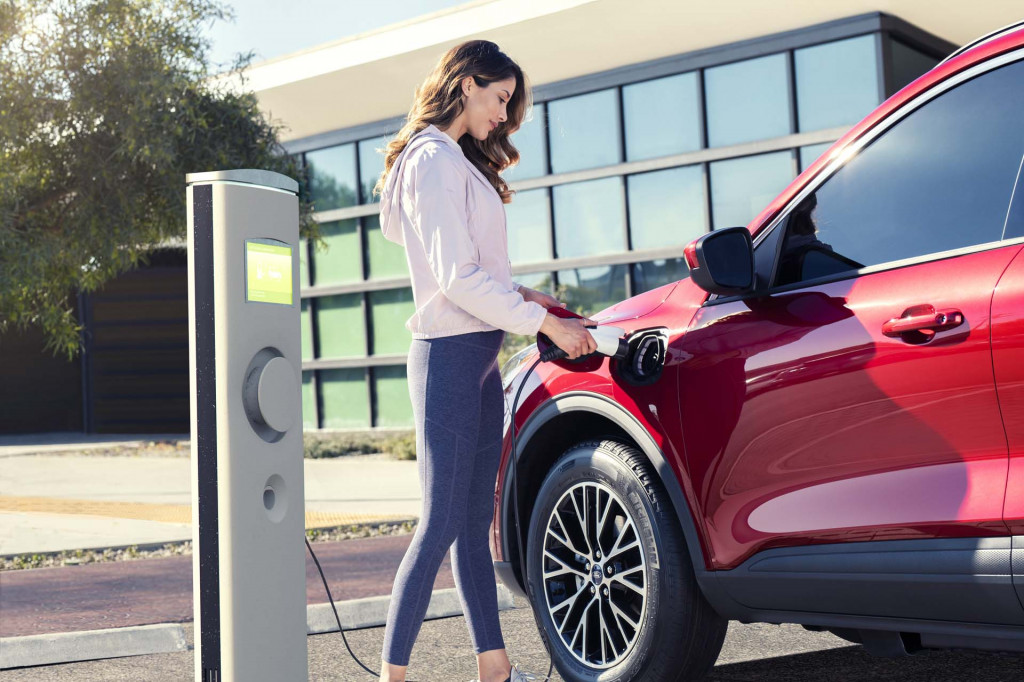My co-driver is lost in text messages as we buzz the Kentucky hills outside Louisville in the 2020 Ford Escape SE Sport Hybrid. Somehow I’ve lulled him into complacency, or maybe it’s the full-size truck rolling slowly ahead, cresting each hill with a thump that threatens to toss some of its bed contents our way.
I tap the “L” at the center of the Escape’s drive-mode selector, and additional regen slows the car to give us more room for debris avoidance. The Escape’s engine groans to life every so often as we unreel miles of pavement, and I keep an eye on the Escape’s digital gauge cluster.
Even though we’ve whipped through curves and nicked corners with precise, un-hybrid-like steering, the numbers don’t lie—they may exaggerate, yes—and we’re showing 41.2 mpg on the route, 19.1 miles traveled on electric out of 45.7 total. The 2020 Ford Escape SE Sport Hybrid has outdone itself.
2020 Ford Escape
Return of the hybrid
The last Escape Hybrid left Ford’s lineup in 2012, but the gas-electric crossover returns this year as a tag team.
Gas-only 2020 Escapes come with either a 180-hp turbo-3 engine or a 250-hp turbo-4 coupled to an 8-speed automatic that channels power to the front wheels or to all four wheels. Fuel economy of up to 30 mpg combined emanates from the front-drive turbo-3.
With either of the new hybrid models, that number rises by at least 30 percent in combined driving. Today we’re besting that with the non-plug-in Hybrid, which pairs an electric motor with a 2.5-liter inline-4 and a 1.1-kwh lithium-ion battery pack. The pack’s cells are supplied by Panasonic, in a briefcase-sized parcel that sits below the rear passenger seat.
Engineers have used the occasion not just to switch from nickel metal hydride batteries to lithium-ion, but to rely on that battery pack far more often to supplant the gas engine for efficiency that approaches that of the former C-Max Hybrid.
Through a redeveloped electronic CVT and front- or all-wheel drive (no through-the-road AWD, engineers say, for reasons of efficiency), Ford draws a net of 200 hp from the Escape’s new hybrid drivetrain, with 152 lb-ft of torque from the gas engine alone.
The eCVT uses a motor that couples with the engine via a planetary gear, like the setup in the Toyota Prius. The complex software managing these mechanicals—and the battery’s charge—in the 2020 Escape Hybrid call on the gas engine less than the C-Max or Escape Hybrid.
As we slung the hybrid through Kentucky back roads, the engine’s gruff note came on episodically rather than constantly. The ‘L’ button’s regen helped us game the powertrain over the 40-mpg barrier easily, as often as we could engage it on downhill stretches. With the delayed rise of engine revs to prods of the accelerator, the powertrain behaved, in some ways, like early Chevy Volts and the late, unloved Cadillac ELR—all to the Escape’s fuel-economy benefit.
Those soaring fuel-economy numbers are nearly the only clue that the SE Sport Hybrid we sampled was a hybrid. It steered with crisp response, and its ride felt nearly as well-controlled as the 250-hp car we’d driven the day before. It’s quiet, too, at least in Titanium trim, where the active noise cancellation that comes with all Escape hybrids gets augmented by laminated acoustic glass.
It’s as close as Ford has come to a penalty-free hybrid. Final EPA numbers still are in the offing, though engineers told Green Car Reports that they expect to equal or better the Toyota RAV4 Hybrid’s 40-mpg EPA combined rating. That would also land in a competitive spot against the upcoming Honda CR-V Hybrid.
2020 Ford Escape
Like the Escape, only better
The Escape hybrid doesn’t vary much in other ways from the gas-powered Escapes. It shares their vaguely Model 3-like front end styling, and gets a full digital gauge display as standard, while it’s an option on other models.
Inside, the hybrid loses slight amounts of interior capacity. Its second-row seat slides a bit less (about two inches) than the gas-only car due to the battery placement, and its interior volume is down about 5 cubic feet to about 60 cubic feet total for the same reason.
Safety features include standard automatic emergency braking, but beyond that, the 2020 Escape SE Sport Hybrid comes with a power tailgate, a panoramic roof, navigation, adaptive cruise control, 19-inch wheels, the 12.3-inch digital gauge cluster, and black trim—all for $29,450.
Of course, there’s more available. The $34,595 Escape Titanium comes with the hybrid drivetrain standard, and adds B&O sound, 19-inch wheels, navigation, leather upholstery, acoustic glass, ambient lighting, and a 110-volt AC power outlet. It also gets active park assist with front and rear parking sensors and active lane control. The SE Sport Hybrid in particular, we think, is a compelling bargain priced precisely to lure in more buyers and to offset the fuel-quaffing tendencies of Ford’s hot lineup of full-size trucks and SUVs.
2020 Ford Escape
Escape plug-in hybrid: 30 miles better?
The hybrid’s on sale now—but should you wait?
In the spring, Ford will add a plug-in Escape Hybrid to the fleet. There will not be a fully electric Escape in this generation; Ford has other battery-electric vehicles in the works, and there’s not enough pack space under the Escape floor.
But the Escape plug-in could be an even stronger draw than the non-plug model. The 209-hp plug-in hybrid powertrain will sport an upsized 14.4-kwh lithium-ion battery, made up of Samsung cells, that can be charged in 3.5 hours on a Level 2 240-volt charging station for about 30 miles of electric-only range.
Both hybrids can be run on battery power alone, but the plug-in will have a few dedicated drive modes, including one to maintain charge state for electric-only use in quiet spaces.
The plug-in Escape will only be available with front-wheel drive—but it will be eligible for federal and local tax incentives that the hybrid will not.
More patience may pay off for drivers who demand a plug-in car in their driveway. For others, the 2020 Ford Escape Hybrid marks the welcome return of a greener SUV—and maybe a return to common sense.
Ford provided airfare and hotel so that we could bring you this first drive review.



















